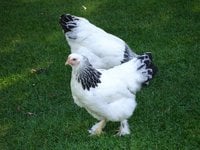We had two Brahma hens for a couple of years in our mixed-breed flock before we gave the whole flock away due to them not laying many eggs anymore. Their color was Partridge, which I find stuning. They were all-in-all very beautiful, with a burly and fluffy sort of built, unlike most other chicken breeds that have a more streamlined look to them.
They hade a rose comb, meaning they barely had a comb at all, merely a low ridge of skin on the top of their head. Such a comb is unusually resistant to frost-bite. That, along with the hens' tight plumage and large size, made them resistant to the cold of Swedish winter. On the down side, our Brahmas stood around panting in the summer heat more than any other of our chickens.
Another double-edged sword about them is that they have heavily feathered feet. This is beautiful and rather unusual, but I've read that it makes it easier for them to get scaly leg mites, and our Brahas did indeed suffer from that condition. One treatment seemed to cure them, though. Furthermore, such feet-feathers are prone to get muddy, and wet in winter, which increases the risk of them getting frostbitten toes. And apparantly they don't help the chickens' feet stay warm in the cold. All in all, I think the downsides of foot feathering outweigh the upsides.
The Brahmas got broody a lot, which for us was mostly a con, beause we were more interested in getting eggs than more chickens. When we let them sit on the eggs, they became great mothers.
As I said, they are very large chickens, which has pros and cons of its own. I've already mentioned temperature handling. Apart from that, large size seems to deter raptors around our area; they are more interested in small birds. But their heaviness makes them bad fliers. And while this may make it easier to fence them in, it also forced us to build a ramp for them to reach the roost that was sitting five feet above the floor. They had no problem jumping up into the nests that were about three feet up. Also, we made an extra wide roost, because I'd read that a normal-sized one would risk defoming their breast bone, due to the high pressure such a thin object would cause on their heavy bodies.
One of my favourite things about this breed is that they have heavy brow ridges, giving them a unique eagle gaze.
Another good thing about them is that they seem to be generally restistant to disease. Some of our other chickens got a bit under the weather occasionally, but not the Brahmas.
They are docile, but not overly so. They are not like the Orpingtons we had that just lay around all day; the Bramas aren't super active, but not super-lazy eather, and will forage if allowed to free-range. And while they were rather tame, they wouldn't let us touch them.
Overall I would recommend the breed for anyone wanting to add a huge chicken to the flock.
They hade a rose comb, meaning they barely had a comb at all, merely a low ridge of skin on the top of their head. Such a comb is unusually resistant to frost-bite. That, along with the hens' tight plumage and large size, made them resistant to the cold of Swedish winter. On the down side, our Brahmas stood around panting in the summer heat more than any other of our chickens.
Another double-edged sword about them is that they have heavily feathered feet. This is beautiful and rather unusual, but I've read that it makes it easier for them to get scaly leg mites, and our Brahas did indeed suffer from that condition. One treatment seemed to cure them, though. Furthermore, such feet-feathers are prone to get muddy, and wet in winter, which increases the risk of them getting frostbitten toes. And apparantly they don't help the chickens' feet stay warm in the cold. All in all, I think the downsides of foot feathering outweigh the upsides.
The Brahmas got broody a lot, which for us was mostly a con, beause we were more interested in getting eggs than more chickens. When we let them sit on the eggs, they became great mothers.
As I said, they are very large chickens, which has pros and cons of its own. I've already mentioned temperature handling. Apart from that, large size seems to deter raptors around our area; they are more interested in small birds. But their heaviness makes them bad fliers. And while this may make it easier to fence them in, it also forced us to build a ramp for them to reach the roost that was sitting five feet above the floor. They had no problem jumping up into the nests that were about three feet up. Also, we made an extra wide roost, because I'd read that a normal-sized one would risk defoming their breast bone, due to the high pressure such a thin object would cause on their heavy bodies.
One of my favourite things about this breed is that they have heavy brow ridges, giving them a unique eagle gaze.
Another good thing about them is that they seem to be generally restistant to disease. Some of our other chickens got a bit under the weather occasionally, but not the Brahmas.
They are docile, but not overly so. They are not like the Orpingtons we had that just lay around all day; the Bramas aren't super active, but not super-lazy eather, and will forage if allowed to free-range. And while they were rather tame, they wouldn't let us touch them.
Overall I would recommend the breed for anyone wanting to add a huge chicken to the flock.

